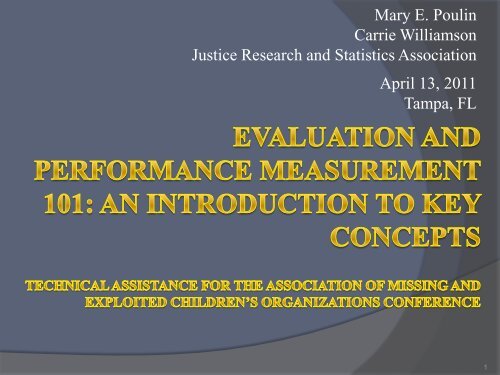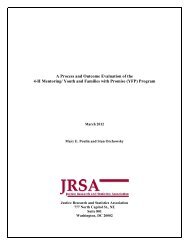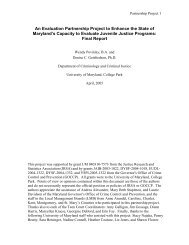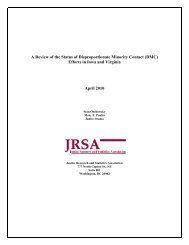Evaluation and Performance Measurement 101: An Introduction to ...
Evaluation and Performance Measurement 101: An Introduction to ...
Evaluation and Performance Measurement 101: An Introduction to ...
Create successful ePaper yourself
Turn your PDF publications into a flip-book with our unique Google optimized e-Paper software.
Mary E. Poulin<br />
Carrie Williamson<br />
Justice Research <strong>and</strong> Statistics Association<br />
April 13, 2011<br />
Tampa, FL<br />
1
National Juvenile Justice <strong>Evaluation</strong> Center<br />
(NJJEC)<br />
A project of JRSA funded by the Office of<br />
Juvenile Justice <strong>and</strong> Delinquency Prevention<br />
(OJJDP)<br />
Improve the ability of states, tribes, <strong>and</strong> local<br />
communities <strong>to</strong> evaluate their juvenile justice<br />
programs<br />
Facilitate the use of evidence-based practices<br />
in juvenile justice<br />
2
Goals for Today:<br />
Underst<strong>and</strong> the value of program moni<strong>to</strong>ring<br />
<strong>and</strong> evaluation in program sustainability<br />
Gain a working, useable knowledge of basics<br />
regarding performance measurement <strong>and</strong><br />
evaluation<br />
3
What do you hope <strong>to</strong> learn <strong>to</strong>day?<br />
4
Why Measure Program <strong>Performance</strong>?<br />
COMPETE for grant funding, sponsorship, donations<br />
TRACK program implementation in an objective,<br />
systematic way<br />
MODIFY program design <strong>and</strong> implementation <strong>to</strong><br />
improve outcomes<br />
DEMONSTRATE that the program is accomplishing its<br />
objectives<br />
FACILITATE agency planning <strong>and</strong> budgeting<br />
ADHERE <strong>to</strong> federal requirements<br />
CONTRIBUTE <strong>to</strong> knowledge about what works<br />
5
OJJDP <strong>and</strong> <strong>Performance</strong> <strong>Measurement</strong><br />
Per federal legislation, all grantees must provide data that<br />
measures the results of their work<br />
OJJDP has developed measures for each funding stream<br />
Quarterly data are submitted online<br />
EXAMPLE: Child Protection Division Fellowship Program<br />
on Children’s Exposure <strong>to</strong> Violence<br />
• Number of people trained<br />
• Number of trainings held<br />
• Number of program policies changed, improved, or<br />
rescinded<br />
See www.ojjdp.gov for more examples<br />
6
Today’s Topics<br />
<strong>Performance</strong> measurement v. <strong>Evaluation</strong><br />
Key terms in performance measurement<br />
Logic models<br />
How <strong>to</strong> write performance measures<br />
Working with an evalua<strong>to</strong>r<br />
Next steps<br />
7
<strong>Performance</strong> <strong>Measurement</strong> v.<br />
<strong>Evaluation</strong><br />
8
<strong>Performance</strong> <strong>Measurement</strong><br />
Concerned with collecting information <strong>to</strong><br />
determine whether a program is achieving<br />
its objectives<br />
Focus on performance measures (program<br />
implementation <strong>and</strong>/or outcome measures)<br />
<strong>and</strong> reporting program outcomes<br />
Information is used <strong>to</strong> improve program<br />
operation <strong>and</strong>/or design<br />
9
<strong>Evaluation</strong><br />
Assesses the effectiveness of a program in<br />
achieving its objectives<br />
Determines whether program outcome(s) can<br />
be attributed <strong>to</strong> the program or other fac<strong>to</strong>rs<br />
Aims at program improvement through<br />
modification of program operation <strong>and</strong>/or<br />
design<br />
10
Use <strong>Performance</strong><br />
<strong>Measurement</strong> <strong>and</strong> <strong>Evaluation</strong>…<br />
INTERNALLY, <strong>to</strong> improve<br />
program effectiveness <strong>and</strong><br />
implementation<br />
EXTERNALLY, <strong>to</strong> advocate<br />
for continued or additional<br />
funding <strong>and</strong> support <strong>and</strong><br />
contribute <strong>to</strong> knowledge in<br />
your field<br />
11
<strong>Performance</strong> <strong>Measurement</strong> <strong>An</strong>swers:<br />
Are we serving our target population?<br />
Are activities being implemented as planned?<br />
Are we accomplishing our objectives?<br />
<strong>Evaluation</strong> <strong>An</strong>swers:<br />
The same questions as performance measurement<br />
AND….<br />
Can outcomes be attributed <strong>to</strong> program activities?<br />
Did one intervention have a greater impact on outcomes<br />
than another intervention?<br />
12
How are <strong>Performance</strong> <strong>Measurement</strong> <strong>and</strong><br />
<strong>Evaluation</strong> Similar?<br />
<br />
<br />
<br />
<br />
<br />
Focus on performance<br />
Information can be used for moni<strong>to</strong>ring <strong>and</strong><br />
improvement<br />
There are many ways <strong>to</strong> design performance<br />
measurements <strong>and</strong> evaluations<br />
For both approaches, some designs are stronger than<br />
others<br />
<strong>Performance</strong> measurement generates evaluative<br />
information<br />
13
How are <strong>Performance</strong> <strong>Measurement</strong> <strong>and</strong><br />
<strong>Evaluation</strong> Different?<br />
<strong>Evaluation</strong> uses means <strong>to</strong> determine whether<br />
the outcomes of the program can be attributed<br />
<strong>to</strong> the program or other fac<strong>to</strong>rs<br />
• For example:<br />
○Comparison or control groups<br />
○R<strong>and</strong>om assignment <strong>to</strong> treatment<br />
<strong>Evaluation</strong> provides more information<br />
regarding program performance<br />
14
Key Terms in <strong>Performance</strong><br />
<strong>Measurement</strong><br />
15
<strong>Performance</strong> Measures<br />
Process (a.k.a. Output) Measures: address<br />
program implementation; directly tied <strong>to</strong> activities<br />
Outcome Measures: address program<br />
accomplishments; directly tied <strong>to</strong> objectives<br />
Example:<br />
Internet safety video is shown <strong>to</strong> 50<br />
children [PROCESS]<br />
45/50 children pass internet safety test after<br />
watching video [OUTCOME]<br />
16
Examples of Process Measures<br />
Number of participants who completed an<br />
classroom-based internet safety program<br />
during the school year<br />
Number of fliers distributed with information<br />
regarding missing children in the past year<br />
Number of Child ID cards created during a<br />
one-month period<br />
17
Examples of Outcome Measures<br />
Changes in internet safety knowledge among<br />
parents, children, <strong>and</strong> teens<br />
Changes in child behavior related <strong>to</strong> personal<br />
safety<br />
Speed of community responses <strong>to</strong> reports of<br />
missing children<br />
Number of missing children recovered safely<br />
18
Definitions of Goals, Objectives,<br />
Activities<br />
Goals speak <strong>to</strong> the overarching mission of a<br />
program <strong>and</strong> are generally limited <strong>to</strong> one.<br />
May not be reached during program<br />
operation.<br />
Objectives are measurable, identify the target<br />
population, offer a timeframe for completion,<br />
<strong>and</strong> expected direction of change<br />
Activities are very specific tasks that will be<br />
pursued during the program’s operation<br />
19
Example of an unclear goal:<br />
To reduce internet victimization of youth<br />
Example of a clear goal:<br />
To reduce internet-related victimization of middle<br />
<strong>and</strong> high school students nationwide through<br />
education <strong>and</strong> empowerment programming<br />
Example of an unclear objective:<br />
To increase youth awareness about internet<br />
victimization<br />
Example of a clear objective:<br />
To increase middle <strong>and</strong> high school students’<br />
internet safety awareness during the 2011-2012<br />
school year<br />
20
Example of an unclear activity:<br />
<br />
Hold internet safety programs for youth<br />
Example of a clear activity:<br />
<br />
Hold classroom-based age-appropriate internet<br />
safety programs for middle <strong>and</strong> high school<br />
students once a month during the 2011-2012<br />
school year<br />
21
Differentiating Objectives <strong>and</strong><br />
Activities<br />
Plan <strong>to</strong> do = Activity<br />
Want <strong>to</strong> do because…= Objective<br />
22
Writing Objectives <strong>and</strong> Activities<br />
Objectives<br />
To improve the ability of<br />
law enforcement <strong>to</strong> respond<br />
<strong>to</strong> missing child reports<br />
Activities<br />
______________________<br />
______________________<br />
______________________<br />
______________________<br />
______________________<br />
______________________<br />
Provide counseling services<br />
<strong>to</strong> all teenagers in the<br />
county who report<br />
experiencing dating<br />
violence<br />
23
Logic Models<br />
24
Logic Model<br />
Connect elements of program: goals,<br />
objectives, activities, performance<br />
measures<br />
Goal<br />
Objectives Activities Process Measures Outcomes Outcome<br />
Measures<br />
25
Program Theory: Internet Safety<br />
Specifies the logical relationships between the<br />
program's goal(s), objectives, <strong>and</strong> activities.<br />
IF age-appropriate internet safety resources <strong>and</strong> information are<br />
offered <strong>to</strong> parents of teenagers [activity]<br />
THEN the ability of parents <strong>to</strong> teach teens about internet safety will<br />
increase [objective]<br />
<strong>An</strong>d IF parents disseminate internet safety resources <strong>and</strong> information<br />
<strong>to</strong> teenagers [activity]<br />
THEN teens will be more aware of internet safety issues <strong>and</strong> take<br />
steps <strong>to</strong> protect themselves [objective].<br />
THEN Internet victimization of teenagers will be reduced. [goal]<br />
26
Child Abduction Prevention Program:<br />
Goal<br />
Prevent child abduction nationwide through<br />
school-based awareness programs.<br />
27
Child Abduction Prevention Program:<br />
Objectives<br />
During the 2011-2012 school year [TIMEFRAME],<br />
increase [DIRECTION]<br />
the number of elementary school children [TARGET<br />
POPULATION]<br />
who are aware of suspicious behaviors that may<br />
result in abduction.<br />
28
Child Abduction Prevention Program:<br />
Activities<br />
Provide parents of elementary school children<br />
with facts, tips, <strong>and</strong> discussion starters on child<br />
abduction on a web site<br />
Provide elementary school children in 100 schools<br />
with a training on how <strong>to</strong> respond during an<br />
attempted abduction<br />
Disseminate age-appropriate information <strong>to</strong><br />
elementary school children on a web site about<br />
“bad” adult behaviors that could be harmful <strong>to</strong><br />
children<br />
29
Selecting <strong>Performance</strong> Measures<br />
Is this a good measure?<br />
Do I have enough measures?<br />
How do I define <strong>and</strong> select measures?<br />
30
How <strong>to</strong> write performance<br />
measures<br />
31
Defining <strong>and</strong> Selecting Measures<br />
Clear definition of terms <strong>and</strong> how they are measured<br />
How specific does the measure need <strong>to</strong> be?<br />
• Are you making comparisons across agencies?<br />
• To whom is the measure being reported?<br />
Example:<br />
“Clients served”<br />
• Who are the clients?<br />
○ Individuals or groups?<br />
• What is the time frame for service?<br />
○ E.g., in the past year, in the past month<br />
• Does the type of service matter?<br />
32
Is This a Good Measure?<br />
Objective indica<strong>to</strong>r of success<br />
Relevant- Directly related <strong>to</strong><br />
objective (outcome measure) or<br />
activity (process measure)<br />
Clear <strong>and</strong> specific<br />
Able <strong>to</strong> indicate gradations of<br />
success<br />
Reliable- If you use it multiple<br />
times will you get the same result?<br />
Valid- Does it actually elicit the<br />
intended information?<br />
33
Is This a Good Measure?<br />
Will it produce findings that you will be able <strong>to</strong><br />
analyze <strong>and</strong> underst<strong>and</strong>?<br />
Practical (e.g., Is it <strong>to</strong>o long, complex, or<br />
expensive?)<br />
Is it reasonable <strong>to</strong> expect that the<br />
program/intervention can affect the measure?<br />
Are other similar programs using this performance<br />
measure?<br />
Do you have measures <strong>to</strong> indicate positive <strong>and</strong><br />
negative results?<br />
34
Improving Your Measures<br />
Number of fliers distributed<br />
Number of missing child fliers<br />
distributed within 48 hours of missing<br />
child report<br />
Number of missing child fliers<br />
distributed in the past year within 48<br />
hours of missing child report<br />
35
<strong>Performance</strong> Measure: Process or<br />
Outcome?<br />
Prevention programs<br />
• Number of children attending sessions<br />
during the past year<br />
• Percent of attendees exhibiting improved<br />
subject knowledge after training<br />
Child recovery programs<br />
• Number of volunteers involved in physical<br />
searches for missing children during the past<br />
year<br />
• Percent of missing children safely recovered<br />
36
Do I Have Enough Measures?<br />
Logic Model <strong>and</strong> Program Theory<br />
Process <strong>and</strong> Outcome<br />
Address Key Activities <strong>and</strong> Objectives<br />
Short <strong>and</strong> Long Term<br />
Multiple Process <strong>and</strong> Outcome Measures (3-5<br />
each)<br />
37
Exercise: Create A Logic Model<br />
GOAL:<br />
OBJECTIVES ACTIVITIES PROCESS<br />
MEASURES<br />
OUTCOME<br />
MEASURES<br />
38
After data collection:<br />
Minimally, be able <strong>to</strong> present numbers by<br />
type of service, population served, time<br />
frame<br />
Educate gran<strong>to</strong>rs, sponsors, <strong>and</strong><br />
legisla<strong>to</strong>rs on what the program can<br />
reasonably accomplish<br />
All results should be used <strong>and</strong> shared<br />
internally <strong>and</strong> externally<br />
Share good <strong>and</strong> bad results <strong>to</strong> facilitate<br />
learning <strong>and</strong> improvement<br />
39
Working with an Evalua<strong>to</strong>r<br />
40
Should I do an evaluation?<br />
Are you meeting objectives?<br />
Do you have capacity <strong>to</strong> participate in data<br />
collection?<br />
Well-defined logic model<br />
Do you have unanswered questions regarding<br />
cause-effect?<br />
Time <strong>to</strong> wait for evaluation<br />
Resources <strong>to</strong> expend on evaluation<br />
Seeking objective assessment of program<br />
41
How do I work with an evalua<strong>to</strong>r?<br />
Seek:<br />
Graduate-level training<br />
Experience in program evaluation<br />
Philosophy match<br />
• Collaborative v. independent<br />
Communication skills<br />
Develop:<br />
Timeline<br />
Task list<br />
Products<br />
42
How do I work with an evalua<strong>to</strong>r?<br />
(Cont.)<br />
Find:<br />
Professional Organizations<br />
• American <strong>Evaluation</strong> Association,<br />
American Society of Criminology<br />
Colleges/ Universities<br />
State/ Local Agencies<br />
Federal Government<br />
43
Next Steps<br />
What data are you currently collecting?<br />
Why?<br />
What questions do you want <strong>to</strong> answer about<br />
your program?<br />
Create or revise logic model(s)<br />
Make a plan for using the data you collect<br />
44
Questions?<br />
45

















